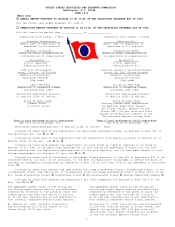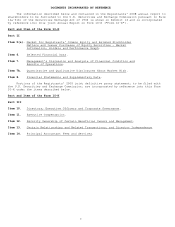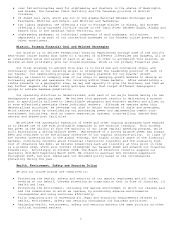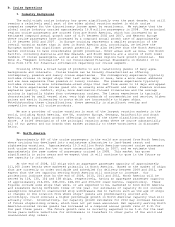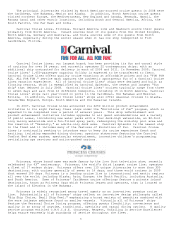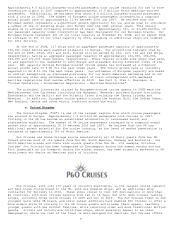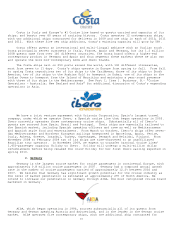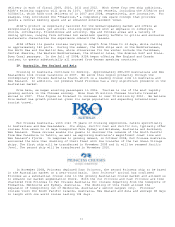Carnival Cruises 2008 Annual Report Download - page 5
Download and view the complete annual report
Please find page 5 of the 2008 Carnival Cruises annual report below. You can navigate through the pages in the report by either clicking on the pages listed below, or by using the keyword search tool below to find specific information within the annual report.
5
B. Cruise Operations
I. Industry Background
The multi-night cruise industry has grown significantly over the past decade, but still
remains a relatively small part of the wider global vacation market in which cruise
companies compete for the discretionary income spent by vacationers. We estimate that the
global cruise industry carried approximately 16.8 million passengers in 2008. The principal
regions cruise passengers are sourced from are North America, which has increased by an
estimated compound annual growth rate of 6.5% between 2002 and 2007, and Western Europe
where cruise passengers have increased by a compound annual growth rate of approximately
11.4% between 2002 and 2007. In Europe cruising represents a smaller proportion of the
overall vacation market than it does in North America and, accordingly, we believe the
European market has significant growth potential. We also believe that the North American
market continues to have considerable growth potential. Other areas such as Asia, the South
Pacific, including Australia and New Zealand, and South America are a source of much lower
numbers of cruise passengers, and we also believe these regions have growth potential. See
Note 11, "Segment Information" to our Consolidated Financial Statements in Exhibit 13 to
this Form 10-K for financial information regarding our cruise segment.
Cruising offers a broad range of products to suit vacationing guests of many ages,
backgrounds and interests. Cruise brands can be broadly characterized as offering
contemporary, premium and luxury cruise experiences. The contemporary experience typically
includes cruises on larger ships that last seven days or less, have a more casual ambiance
and are less expensive than premium or luxury cruises. The premium experience typically
includes cruises on more intermediate-sized ships that last from seven to 14 days and appeal
to the more experienced cruise guest who is usually more affluent and older. Premium cruises
emphasize quality, comfort, style, more destination-focused itineraries and the average
pricing is typically higher than contemporary cruises. The luxury experience is typically
characterized by small vessel size, very high standards of accommodation and service, higher
prices and exotic itineraries to ports which are inaccessible to bigger ships.
Notwithstanding these classifications, there generally is significant overlap and
competition among all cruise products.
We are a provider of cruise vacations in most of the largest vacation markets in the
world, including North America, the UK, southern Europe, Germany, Asia/Pacific and South
America, with significant product offerings in each of the three classifications noted
above. A brief description of the principal vacation areas where we source substantially
all of our guests and our brands that market primarily to these vacationers is discussed
below.
II. North America
Approximately 66% of the cruise passengers in the world are sourced from North America,
where cruising has developed into a mainstream alternative to land-based resort and
sightseeing vacations. Approximately 10.5 million North American-sourced cruise passengers
took cruise vacations for two or more consecutive nights in 2007, and we estimate that
approximately the same number of passengers cruised in 2008. This market has grown
significantly in prior years and we expect that it will continue to grow in the future as
new capacity is introduced.
At the end of 2008, 122 ships with an aggregate passenger capacity of approximately
211,000 lower berths were marketed primarily in North America. Based on the number of ships
that are currently on order worldwide and scheduled for delivery between 2009 and 2012, we
expect that the net capacity serving North America will continue to increase. Our
projections indicate that by the end of 2009, 2010, 2011 and 2012, North America will be
served by 124, 130, 136 and 138 ships, respectively, having an aggregate passenger capacity
of approximately 213,000, 233,000, 248,000 and 253,000 lower berths, respectively. These
figures include some ships that were, or are expected to be, marketed in both North America
and elsewhere during different times of the year. Our estimates of capacity do not include
assumptions related to unannounced ship withdrawals due to factors such as the age of ships
or changes in the location from where ships' guests are predominantly sourced and,
accordingly, could indicate a higher percentage growth in North American capacity than will
actually occur. Alternatively, our capacity growth estimates for 2012 may increase because
of future shipbuilding orders, which have not yet been announced. Net capacity serving North
American-sourced cruise guests has increased at a compound annual growth rate of 3.3% for
the past three years. The future growth rate is currently expected to be 5.6% for the next
three years before reductions for withdrawals or transfers to other parts of the world and
unannounced ship orders.

